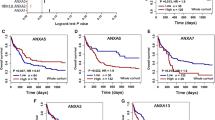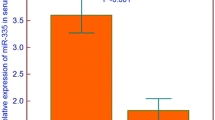Abstract
Acute myeloid leukemia (AML) is one of the major hematological malignancies. Advances in molecular research have greatly improved our understanding of the process of leukemia formation in AML. Osteopontin (OPN) is a novel molecule that mediates critical processes for cancer progression. The aim of this study was to investigate the relative expression of OPN gene isoforms in AML patients on days 0, 14, and 28 after chemotherapy. The bone marrow samples were collected from 40 newly diagnosed AML patients (24 male and 16 female with a mean age of 30 years) at the initial time of diagnosis, 14 and 28 days after treatment. The peripheral blood samples of 10 healthy individuals were also collected as the control group. The expression of OPN isoforms was investigated by Real-Time Quantitative PCR. The expression of VEGFc/STAT3/CXCR4 was also investigated by Real-Time PCR. Findings indicated that OPNb and OPNc isoforms had significantly overexpression in AML patients on 14 and 28 days after treatment compared to normal samples (P < 0.05). The level of OPNb and OPNc isoforms was increased significantly in M0, M1, and M2 subgroups with overexpression of VEGFc/STAT3/CXCR4, 28 days after starting chemotherapy (P < 0.05). Our results suggested that OPNb and OPNc isoforms play a major role in cancer relapse. Therefore, they can be used as a valuable prognostic and diagnostic biomarker for relapse of the AML disease. However, these findings need confirmation with further studies.


Similar content being viewed by others
References
Beyar-Katz O, Gill S. Novel approaches to acute myeloid leukemia immunotherapy. Clin Cancer Res. 2018;24(22):5502–15.
Creutzig U, et al. Acute myelogenous leukemia in adolescents and young adults. Pediatr Blood Cancer. 2018;65(9):e27089.
Döhner H, et al. Diagnosis and management of AML in adults: 2017 ELN recommendations from an international expert panel. Blood. 2017;129(4):424–47.
Short NJ, Rytting ME, Cortes JE. Acute myeloid leukaemia. Lancet. 2018;392(10147):593–606.
Network CGAR. Genomic and epigenomic landscapes of adult de novo acute myeloid leukemia. N Engl J Med. 2013;368(22):2059–74.
Mirzaei A, et al. Osteopontin b and c isoforms: Molecular candidates associated with leukemic stem cell chemoresistance in acute myeloid leukemia. Asian Pac J Cancer Prev. 2017;18(6):1707.
Mirzaei A, et al. Osteopontin b and c splice isoforms in leukemias and solid tumors: angiogenesis alongside chemoresistance. Asian Pac J Cancer Prev. 2018;19(3):615–23.
Shevde LA, Samant RS. Role of osteopontin in the pathophysiology of cancer. Matrix Biol. 2014;37:131–41.
Tilli TM, et al. Osteopontin-c splicing isoform contributes to ovarian cancer progression. Mol Cancer Res. 2011;9(3):280–93.
Gimba E, Tilli T. Human osteopontin splicing isoforms: known roles, potential clinical applications and activated signaling pathways. Cancer Lett. 2013;331(1):11–7.
Briones-Orta MA, et al. Osteopontin splice variants and polymorphisms in cancer progression and prognosis. Biochim et Biophys Acta (BBA)-Rev Cancer. 2017;1868(1):93-108.A.
Bennett JM, et al. Proposed revised criteria for the classification of acute myeloid leukemia: a report of the French-American-British Cooperative Group. Ann Intern Med. 1985;103(4):620–5.
Schmittgen TD, Livak KJ. Analyzing real-time PCR data by the comparative C T method. Nat Protoc. 2008;3(6):1101.
Mirzaei A, et al. OPN b and c isoforms doubtless veto anti-angiogenesis effects of curcumin in combination with conventional AML regiment. Asian Pac J Cancer Prev. 2017;18(9):2591–9.
Vardiman JW, Harris NL, Brunning RD. The World Health Organization (WHO) classification of the myeloid neoplasms. Blood. 2002;100(7):2292–302.
Huang R-H, et al. Osteopontin promotes cell migration and invasion, and inhibits apoptosis and autophagy in colorectal cancer by activating the p38 MAPK signaling pathway. Cell Physiol Biochem. 2017;41(5):1851–64.
Mohammadi S, et al. Reciprocal interactions of leukemic cells with bone marrow stromal cells promote enrichment of leukemic stell cell compartments in response to curcumin and daunorubicin. Asian Pac J Cancer Prev. 2017;18(3):831.
Mohammadi S, et al. Osteopontin plays a unique role in resistance of CD34+/CD123+ human leukemia cell lines KG1a to parthenolide. Life Sci. 2017;189:89–95.
Patani N, et al. Osteopontin expression profiles predict pathological and clinical outcome in breast cancer. Anticancer Res. 2008;28(6B):4105–10.
Anborgh PH, et al. Pre-and post-translational regulation of osteopontin in cancer. J Cell Commun Signal. 2011;5(2):111–22.
Tilli T, et al. Expression analysis of osteopontin mRNA splice variants in prostate cancer and benign prostatic hyperplasia. Exp Mol Pathol. 2012;92(1):13–9.
Castello LM, et al. Osteopontin at the crossroads of inflammation and tumor progression. Mediat Inflamm. 2017;2017:1–22.
Ferreira LB, et al. Osteopontin-a splice variant is overexpressed in papillary thyroid carcinoma and modulates invasive behavior. Oncotarget. 2016;7(32):52003.
Chae S, et al. Osteopontin splice variants differentially modulate the migratory activity of hepatocellular carcinoma cell lines. Int J Oncol. 2009;35(6):1409–16.
Zhao B, et al. Osteopontin as a potential biomarker of proliferation and invasiveness for lung cancer. J Cancer Res Clin Oncol. 2011;137(7):1061–70.
Yan W, et al. Expression pattern of osteopontin splice variants and its functions on cell apoptosis and invasion in glioma cells. Neuro Oncol. 2010;12(8):765–75.
Siddiqui AA, et al. Osteopontin splice variant as a potential marker for metastatic disease in pancreatic adenocarcinoma. J Gastroenterol Hepatol. 2014;29(6):1321–7.
Hahnel A, et al. Prognostic impact of mRNA levels of osteopontin splice variants in soft tissue sarcoma patients. BMC Cancer. 2012;12(1):131.
Grimwade D, et al. Refinement of cytogenetic classification in acute myeloid leukemia: determination of prognostic significance of rare recurring chromosomal abnormalities amongst 5876 younger adult patients treated in the UK Medical Research Council trials. Blood. 2010;116(3):354–65 (blood-2009-11-254441).
Stone RM, et al. Midostaurin plus chemotherapy for acute myeloid leukemia with a FLT3 mutation. N Engl J Med. 2017;377(5):454–64.
Levis M. FLT3 mutations in acute myeloid leukemia: what is the best approach in 2013? ASH Educ Progr Book. 2013;2013(1):220–6.
Ogawa H, et al. The usefulness of monitoring WT1 gene transcripts for the prediction and management of relapse following allogeneic stem cell transplantation in acute type leukemia. Blood. 2003;101(5):1698–704.
Garg M, et al. Prognostic significance of quantitative analysis of WT1 gene transcripts by competitive reverse transcription polymerase chain reaction in acute leukaemia. Br J Haematol. 2003;123(1):49–59.
Zhang R, et al. Osteopontin enhances the expression and activity of MMP-2 via the SDF-1/CXCR4 axis in hepatocellular carcinoma cell lines. PLoS ONE. 2011;6(8):e23831.
Behera R, et al. Activation of JAK2/STAT3 signaling by osteopontin promotes tumor growth in human breast cancer cells. Carcinogenesis. 2009;31(2):192–200.
Liu X, et al. Activation of STAT3 is involved in malignancy mediated by CXCL12-CXCR4 signaling in human breast cancer. Oncol Rep. 2014;32(6):2760–8.
Florian S, et al. Detection of molecular targets on the surface of CD34+/CD38− stem cells in various myeloid malignancies. Leuk Lymphoma. 2006;47(2):207–22.
Powell JA, et al. Expression profiling of a hemopoietic cell survival transcriptome implicates osteopontin as a functional prognostic factor in AML. Blood. 2009;114(23):4859–70.
Acknowledgements
This study was performed in Hematology, Oncology, and Stem Cell Transplantation Research Center at Tehran University of Medical Sciences.
Funding
None
Author information
Authors and Affiliations
Corresponding author
Ethics declarations
Conflict of interest
The authors declare no conflict of interest.
Additional information
Publisher's Note
Springer Nature remains neutral with regard to jurisdictional claims in published maps and institutional affiliations.
Rights and permissions
About this article
Cite this article
Ferdowsi, S., Ghaffari, S.H., Shiraji, S.T. et al. Investigation of the Osteopontin isoforms expression in patients with acute myeloid leukemia. Med Oncol 38, 102 (2021). https://doi.org/10.1007/s12032-021-01539-1
Received:
Accepted:
Published:
DOI: https://doi.org/10.1007/s12032-021-01539-1




